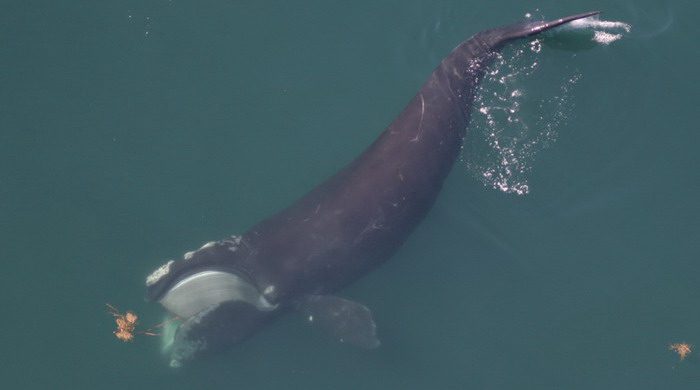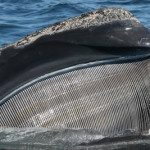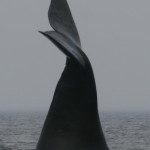May 2007

A right whale exhibits its maneuverability as it makes a sharp turn while subsurface feeding.
(Note that the brown object in front of the whale is seaweed on the surface of the water.)
15 May. Today marks the official end of a busy and successful right whale season here at PCCS. As the right whales move out of Cape Cod Bay, so do many of the members of the right whale team who work seasonally at PCCS. We would like to thank observers Peter Nilsson, Denise Risch and Will Rayment as well as research assistants Trudi Webster and Heather McRae. Seasonal observers and research assistants bring an extraordinary wealth of knowledge and skill to field projects and we would like to thank them for their efforts this season. This season has been exceptionally busy with more then 130 individual right whales sighted in Cape Cod Bay and the adjacent waters. As current estimates believe this population to consist of 350-400 individuals, our sightings include one third of the entire population. Thank you for your interest in these amazing animals and their survival. We will resume posting field notes at the beginning of the 2008 field season.
14 May. The weather forecast for this morning was slightly more promising than the one of the day before. We started our survey in the south of the Bay to cover the lines that we couldn’t cover the day before due to high sea states. Having seen the last two right whales in Cape Cod Bay down here yesterday, we were wondering what we might encounter today. However, it seemed as if the right whales are following their usual pattern of packing up and moving to higher grounds in the middle of May. This was a very quiet survey day with no right whales observed and only three fin whales along the backside of the Cape and a couple of harbor porpoises and seals inside the bay.
13 May. With the official finishing date being May 15th, the end of our right whale field season is approaching fast. From past years experience we know that the whales are usually leaving this area to head for higher latitudes and new feeding grounds, such as the Bay of Fundy, around this time. So with a hinge of end-of-season melancholy we set off from Chatham this morning, curious what we would encounter. Would we find our “backyard†suddenly void of the whales we have been photographing and observing consistently over the last three months? Or would some latecomers still be in the Bay? We started our survey on the backside of the Cape and half-way along this track we started to see a lot of blows and whale bodies about two miles to the east of us. From this distance it was hard to tell which species we were looking at, so we went over to investigate. What we found were about 30 humpback whales all bubble and kick feeding along a slick line. They were accompanied by dozens of dolphins and a couple of fin whales. It was a spectacular sighting of so much marine life that the ocean seemed to be boiling! After we had recorded all the animals we got back on our track and started to survey the Bay. The picture here was much different: we encountered a very quiet body of water on our way south. Additionally, the wind picked up earlier than we had expected so our sightings conditions were deteriorating steadily. At the end of our 12th trackline we decided to abort our survey and head for home. We were already heading towards Chatham and packing our gear away to prepare ourselves for landing when one of our observers looked down and happened to catch a glimpse of two right whales. So we stopped, unpacked the camera and started photographing these two whales, who were feeding subsurface – after all, it wasn’t the end of the season yet!
09 May. After a brief delay due to foggy conditions, the sun broke through and we took off from Chatham airport on our 29th survey flight of the season. There was still fog over the ocean so we started our track lines in the south of Cape Cod Bay. The first right whale we sighted was almost at the western end of our survey tracks, just 3 miles north of the entrance to the Cape Cod Canal. Right whales are very vulnerable to ship strikes so it is crucial that we alert the relevant authorities. At the end of each survey flight we pass on our right whale sightings to Marine Traffic Control at the Cape Cod Canal and to the Sightings Advisory System (coordinated by the National Marine Fisheries Service). By doing this we are helping to minimize the risk of collisions between large vessels and right whales. On this survey flight we only sighted one more right whale before conditions became too windy for surveying and we decided to head for home. Flights at this late stage of the season are important for determining whether right whales are still present in Cape Cod Bay so we are eager to fly again soon.
07 May. With calm winds and good visibility, the aerial survey team began their day surveying along the eastern shore of Cape Cod. While survey conditions were ideal, few whales were sighted along this eastern track line. We quickly worked our way around Race Point finding that the concentration of fin, humpback and right whales around the Race has thinned out considerably. A few miles west of the Race one of the observers spotted two whales to the north. As we broke from our track line to investigate and document which species of whale these were, we realized that this was a humpback and a right whale slowly rolling within a couple of meters of each other. While humpbacks and right whales inhabit the same waters in the spring and summer, it is unusual to find them interacting. These two whales lazily rolled around next to each other, the humpback’s long white flippers almost touching the right whale. After photographing this remarkable sight, we continued our survey. Seven more right whales were sighted within Cape Cod Bay, all of which were single animals feeding at the surface or slightly subsurface. We completed the survey in four and a half hours, a relatively short flight for the 2007 season!
05 May. With a gentle breeze from the north west and partly cloudy skies we started our aerial survey off the eastern shore of Cape Cod. We had logged several minke whales and fin whales by the time we saw our first right whale, near Race Point at the entrance of Cape Cod Bay. For the last couple of weeks we had been seeing large aggregations of right whales in this area, and today was no exception. The whales were relatively spread out and either skim feeding or feeding just below the water surface. This made them easy to photograph and so we were able to spend just a couple of minutes circling above each whale before moving onto the next. As in the previous few days, this area was alive with humpback whales, often feeding co-operatively on the vast schools of baitfish, and putting on a grand show for the whale watch boats in the vicinity. We continued our tracklines to the south, half expecting that we had seen all our right whales for that day. We were somewhat surprised then when we sighted another right whale feeding in the middle of Cape Cod Bay and four more in the far south of the bay. Our last sighting was of two whales that have become very familiar this season. We first saw right whale # 1817, together with her calf of the previous year, back on the 22nd February. Since then we have seen them nine times in Cape Cod Bay, suggesting that they have been pretty much resident in the area for more than two months. These insights into right whale ecology can only be gained from repeated systematic surveys and help remind us of the value of these kind of programs.
03 May. Today started out fairly windy but by late morning our sighting conditions had improved dramatically. Despite the poor conditions early on, the focal follow team managed to track an individual whale for the entire day. The far north of Cape Cod Bay was positively flourishing with life. There were active humpback whales bubble feeding surrounded by birds diving in to take advantage of the fish that had been driven to the surface. Numerous right whales were skim feeding with their heads held high above the water and large curtains of baleen hanging down, like large Skim feeding right whale.lawn mowers hoovering up patches of plankton. Atlantic white sided dolphins were whistling and leaping in amongst the whales to benefit from any stray fish. A mum and calf right whale cruised up and down, the mum with mouth gaping filtering plankton and the calf struggling to keep up with her. There was a brief respite from feeding in the afternoon and a few of the whales joined up in a SAG (surface active group), briefly rolling around together before resuming skimming. The team ended their last focal follow for the season on a high note and are already looking forward to resuming research next year.
03 May. Although we had a good weather forecast, the breeze was already starting to pick up when we took off from Chatham at 9 am this morning in our Cessna Skymaster. Sighting conditions were not ideal as we started our survey off the eastern shore of Cape Cod, with the sea surface strewn with whitecaps. Whitecaps or not, it wasn’t hard to miss our first right whale. The first cue was a huge explosion of whitewater, visible from more than two miles away. Shortly after, the whale breached again, propelling most of its huge bulk above the water before crashing down with an enormous belly-flop. By the time we reached the whale it was swimming slightly more sedately but there were still vast clouds of bubbles remaining from the multiple breaches. As we were circling above this whale, we spotted the next group of whales, a mile and half to the northwest. It was obvious from the multiple blows, waving flukes and foaming water that it was a large surface active group (SAG). We went to investigate and found eight right whales rolling, thrashing and churning the sea surface as they chased each other in tight circles. Photographing SAGs is difficult at the best of times, but with today’s sea conditions it was all the more tricky. Satisfied that we had done the best we could we moved on around the northern tip of Cape Cod. What we found was a veritable sea of whales! Around this time of year large numbers of humpback whales arrive in the seas off Cape Cod to feed on the abundance of small, schooling fish. The most obvious clues to the humpbacks’ presence were the clouds of bubbles erupting at the surface. “Bubble feeding†involves the whale swimming up beneath a school of baitfish and exhaling from its blowholes. The resultant cloud of bubbles drives the fish to the surface while the whale powers up from beneath and scoops up the fish in its mighty gape. In amongst the humpback whales were a number of fin whales, also exploiting the schools of baitfish, and also many right whales. The right whales were feeding further down the food chain, mostly skim feeding through dense clouds of zooplankton. We photographed all the right whales that we could find, while enjoying the spectacle that the other species were laying on. With conditions deteriorating further it was becoming difficult to spot the right whales so we decided to cut our survey short and head for home. Even so, we had seen more than 20 right whales, which is a very good number at this late stage in the season.
02 May. In the early morning hours under a grey sky and frequent rain, the R/V Shearwater set out to survey the food resources of Cape Cod Bay. After the excitement of the 26 April and the directed sampling around feeding right whales, this research cruise was to assess the richness of the planktonic food that directs the distribution of right whales in Cape Cod Bay. Along the beaches as we steamed into the bay, we spotted a coyote along the outer beach, close to the water’s edge while large groups of cormorants and mergansers flew along shore. Starting at station 9N we observed many harbor porpoises scattered across the northern portion of the bay, a pair of dolphins, and a minke whale. As we rounded our stations in the western portion of the bay, the weather began to clear and it was not long before the sun poked through the grey clouds and the sky was a spread of blue. One right whale was seen during the day, traveling rapidly and remaining below the surface for extended periods of time. It was also near the southern-central portion of the bay that we observed hundreds of scoters (a species of marine duck) flying along the horizon. We do not see groups of this season often, and this was a special even to see the horizon filled with not only white-winged scoters, but also surf and black scoters. Several fin whales were observed in the south-eastern corner of the bay, just before we completed our last sampling stations. In all, the team ended the day with a diverse species list and all eight stations sampled during what became beautiful weather conditions.

Our Work
Humpback Whale Research
Right Whale Research
Marine Animal Entanglement Response
Marine Geology Department
Water Quality Monitoring Program
Marine Fisheries Research
Seal Research
Shark Research
Marine Education
Interdisciplinary
Marine Debris and Plastics Program
Marine Policy Initiative
Cape Cod Climate Change Collaborative
Publications




